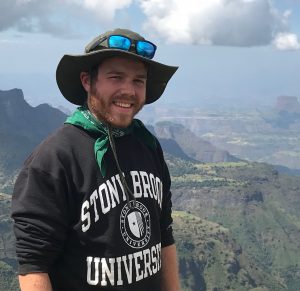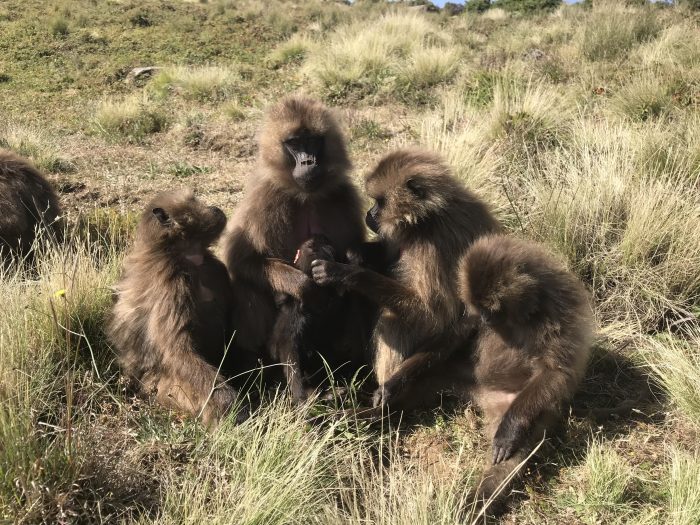SBU’s Feder, Lu discover Goldilocks group size for gelada monkey females
By Daniel Dunaief
Timing can mean the difference between life and death for young geladas (an Old World monkey species). Geladas whose fathers remain leaders of a social group for as much as a year or more have a better chance of survival than those whose fathers are displaced by new males under a year after they’re born.
New males who enter a social group can, and often do, kill the young of other males, giving the new male leaders a chance to impregnate the female members of their social group who might otherwise be unable to conceive.

The odds of a new male leader killing a young gelada are about 60 percent at birth, compared to closer to 15 percent at around a year of age, according to researchers at Stony Brook University (SBU).
Additionally, pregnant gelada monkeys often spontaneously abort their unborn fetuses once a new male enters the group, as the mother’s hormones cause a miscarriage that enables them to dedicate their resources to the future progeny of the next dominant male.
At the same time, the survival of females depends on becoming a part of a group that is just the right size.
Jacob Feder, a graduate student at SBU, and Amy Lu, Assistant Professor in the Department of Anthropology in the College of Arts and Sciences at Stony Brook, recently published a paper in Proceedings of the Royal Society B that explores the ideal group size that optimizes the longevity of females and the number of their offspring.
The researchers discovered a Goldilocks effect. By studying the behavioral and group data for over 200 wild geladas over the course of 14 years, they determined that a mid-size group with five to seven females has the greatest benefit for their own fitness and for the survival of their offspring.
“There tends to be a trade off” in the dynamics that affect female geladas in different groups, Feder said. Females in the biggest groups face a higher risk of takeovers and takeover-related infanticide, since males are more likely to try to dominate a part of larger social groups where they have greater reproductive opportunities.
By contrast, individuals in the smaller groups may live on the periphery of a multi-group dynamic. These females are less protected against predators.
In their native Ethiopia, geladas are vulnerable to leopards, hyenas, and jackals, among others.
For the females, the survival of their offspring depends on the ability of males to remain in the group long enough.
“The male turnover is one of the major drivers of their reproductive success,” explained Feder.
Researchers have seen new males enter a group and kill infants born from another father. The infants, for their part, don’t often recognize the need to avoid new males, Lu said.
When males enter big groups, females often have to reset their reproduction.
Groups with about nine to 11 females often split into units of four to seven, Feder said. A new male might become the leader for half of the females, leaving the remaining male with the other half. Alternatively, new males may take over each group.
The pregnant females who are part of a group with a new male will spontaneously abort their offspring about 80 percent of the time, as females “cut their losses,” Feder said
About 38 percent of females live in a mid-sized group that is close to optimum size.
Gelada charm
According to Feder and Wu, geladas are a compelling species to research, Feder and Wu said.
Feder found his visits to the East African nation rewarding, especially when he had the opportunity to watch a small female named Crimson.
An important part of daily life for these primates involves grooming, where primates comb through each other’s hair, remove insects and, in many cases, eat them.
Crimson, who was a younger member of the group when Feder started observing geladas, didn’t have much grooming experience with this activity. Instead of running her hands over the body of her grooming partner, she focused on her mouth. Her partner’s wide eyes reflected surprise at the unusual grooming choice.
One of the favorites for Lu was a monkey who has since passed away named Vampire. A part of the V group, Vampire was taller and bigger than most adult females. She displaced male geladas, some of whom were larger than she, almost as often as they displaced her.
“If you go out in the field enough, you know the individuals pretty well,” Lu said. “They all have their own personalities. Some of them walk in a different way and react to situations differently.”
A resident of Centereach, Feder grew up in northern Connecticut, attending Wesleyan University as an undergraduate, where he majored in music and biology. A bass guitar player, Feder said he “dabbles in anything with strings.”
In fourth grade, Feder read a biography of Dian Fossey, which sparked his interest in biology.
While he has yet to combine his musical and science interests with geladas, Feder said these monkeys have a large vocabulary that is almost as big as chimpanzees.
Lu, meanwhile, started studying geladas as a postdoctoral researcher. They’re a great study species that allow scientists to ask compelling questions about reproductive strategies. “At any point, you can follow 20 social groups,” Lu said.
Lu, whose two children are four years old and 16 months old, said she has observed the similarities between human and non-human primate young.
“Babies throw tantrums, whether it is my child or a gelada infant protesting being put on the ground,” she described in an email. Gelada infants use a sad “cooing” sound. Sometimes, the sad cooing sound is real and sometimes “they just get what they want.”







